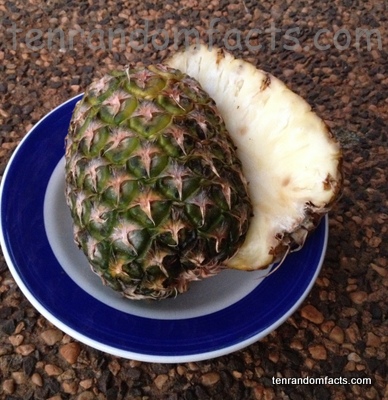Pineapples are not apples from pine trees.
- Pineapples are tropical fruit native to Paraguay and Brazil in South America, and are grown on plants with the scientific name Ananas comosus, that grow to be 1 to 1.5 metres (3.3 to 4.9 feet) in height.
- Pineapples are from the family Bromeliaceae, a family of monocot (one ‘seed leaf’) flowering plants.
- ‘Pineapple’ was the original name for a ‘pine cone’, and pineapples were named so, because of their similar look to conifer tree pine cones.
- Pineapples have a sweet flavour and are commonly eaten raw, particularly in fruit salads; cooked, often on pizza or in other dishes; used crushed in baked goods; and can be juiced to make different beverages.
- The major producers of pineapples in 2009 were the Philippines and Thailand, producing approximately 2 and 1.7 million tonnes (2.2 and 1.9 million tons) respectively, with a world production of 12.9 million tonnes (14.2 million tons).
- Pineapples have either smooth or rough green leaves protruding from the top of the fruit, depending on the variety, and typically yellow coloured spiky skin when ripe, although there are less common red skinned varieties, and the fruit may be harvested green.
- Pineapples have a light yellow or rich yellow juicy flesh, and do not generally ripen after harvesting, nor do they keep well, although they can be kept in the refrigerator to extend their life, and are often preserved by commercial canning methods, making the fruit available for purchase in supermarkets all year round in tinned form.
- Pineapples have a very high content of vitamin C and manganese, and grow to be 20 to 30 centimetres (8 to 12 inches) in height and have a diameter of 10 to 15 centimetres (4 to 6 inches).
- Pineapples have a central hard core running through the middle of the fruit, that contain bromelain enzymes that are commonly used to tenderise meat, and have also been historically used for medicinal purposes, and the enzymes also exist in the flesh of the fruit, although they are destroyed by heat.
- A pineapple is commonly believed to be a single fruit, however it is a combination of many fruits that develop from 150-200 flowers, that merge together and are joined by the core.
Bibliography:
Pineapple, 2012, Fresh for Kids, http://www.freshforkids.com.au/fruit_pages/pineapple/pineapple.html
Pineapple, 2014, Wikipedia, http://en.wikipedia.org/wiki/Pineapple






